Page 219 of 308
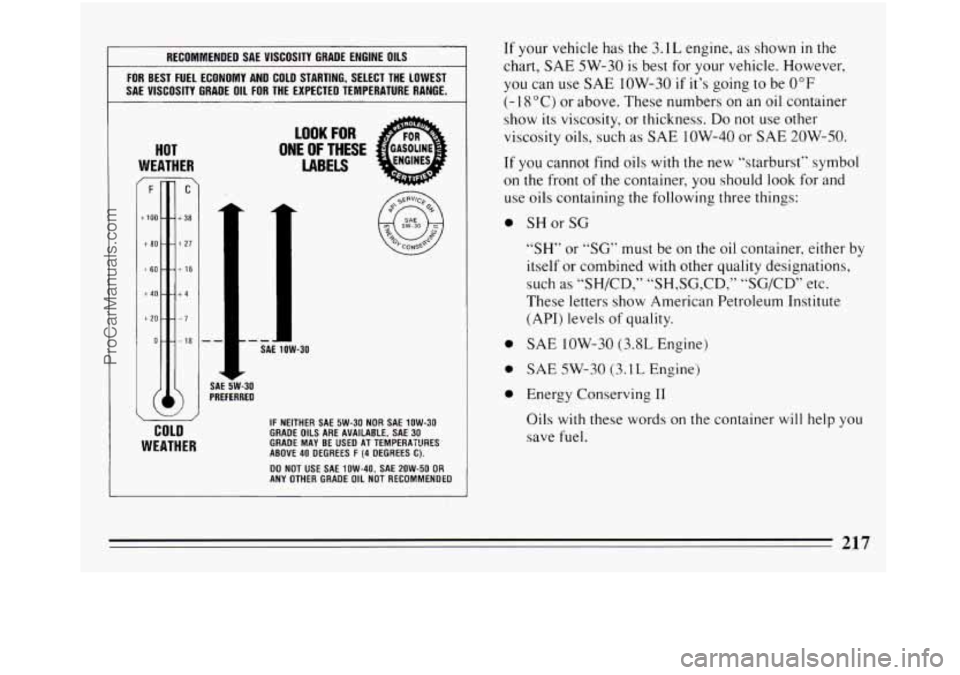
RECOMMENDED SAE VISCOSITY GRADE ENGINE OILS
FOR BEST FUEL ECONOMY AND COLD STARTING, SELECT THE LOWEST
SAE VISCOSITY GRADE
OIL FOR THE EXPECTED TEMPERATURE RANGE.
HOT
WEATHER
r
COLD
WEATHER
LOOK FOR
ONE OF THESE
LABELS
SAE 1OW-30
r
f-30 RED
IF NEITHER SAE 5W-30 NOR SAE 1OW-30
GRADE OILS ARE AVAILABLE, SAE 30
GRADE MAY BE USED AT TEMPERATURES
ABOVE 40 DEGREES
F (4 DEGREES C).
ANY OTHER GRAOE OIL NOT RECOMMENOEO DO NOT USE SAE 1OW-40, SAE 2OW-50 OR
If your vehicle has the 3.1 L engine, as shown in the
chart, SAE
5W-30 is best for your vehicle. However,
you can use SAE
low-30 if it’s going to be 0°F
(- 18 “C) or above. These numbers on an oil container
show its viscosity, or thickness.
Do not use other
viscosity
oils, such as SAE 1OW-40 or SAE 20W-50.
If you cannot find oils with the new “starburst” symbol
on the front of
the container, you should look for and
use oils containing the following three things:
0
0
0
0
SH or SG
“SH” or “SG” must be on the oil container, either by
itself or combined with other quality designations,
such as “SH/CD,” “SH,SG,CD,” “SG/CD” etc.
These letters show American Petroleum Institute
(API) levels of quality.
SAE
low-30 (3.8L Engine)
SAE 5W-30 (3.1L Engine)
Energy Conserving I1
Oils with these words
on the container will help you
save fuel.
217
ProCarManuals.com
Page 220 of 308
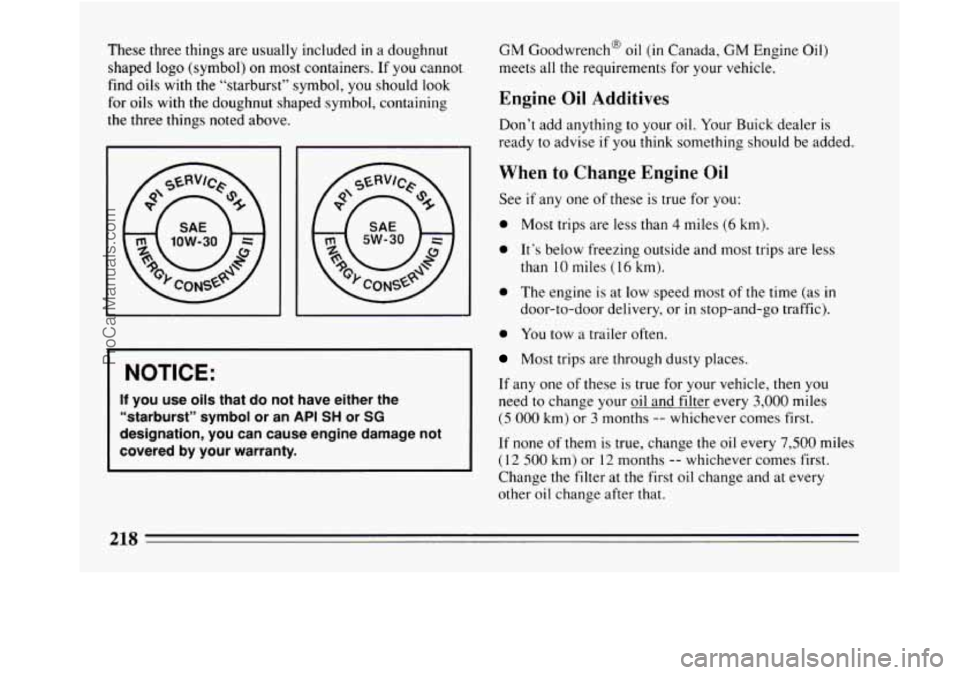
These three things are usually included in a doughnut
shaped logo (symbol)
on most containers. If you cannot
find
oils with the “starburst” symbol, you should look
for oils with the doughnut shaped symbol, containing
the three things noted above.
I NOTICE:
If you use oils that do not have either the
“starburst” symbol or an
API SH or SG
designation, you can cause engine damage not
covered by your warranty.
GM Goodwrench@ oil (in Canada, GM Engine Oil)
meets all the requirements for your vehicle.
Engine Oil Additives
Don’t add anything to your oil. Your Buick dealer is
ready to advise
if you think something should be added.
When to Change Engine Qil
See if any one of these is true for you:
0 Most trips are less than 4 miles (6 km).
0 It’s below freezing outside and most trips are less
than
10 miles ( 16 km).
0 The engine is at low speed most of the time (as in
door-to-door delivery, or in stop-and-go traffic).
0 You tow a trailer often.
Most trips are through dusty places.
If any one of these is true for your vehicle, then you
need to change your oil and filter every
3,000 miles
(5 000 km) or 3 months -- whichever comes first.
If none of them is true, change the oil every 7,500 miles
(12 500 km) or 12 months -- whichever comes first.
Change the filter at the first oil change and at every
other
oil change after that.
218
ProCarManuals.com
Page 221 of 308
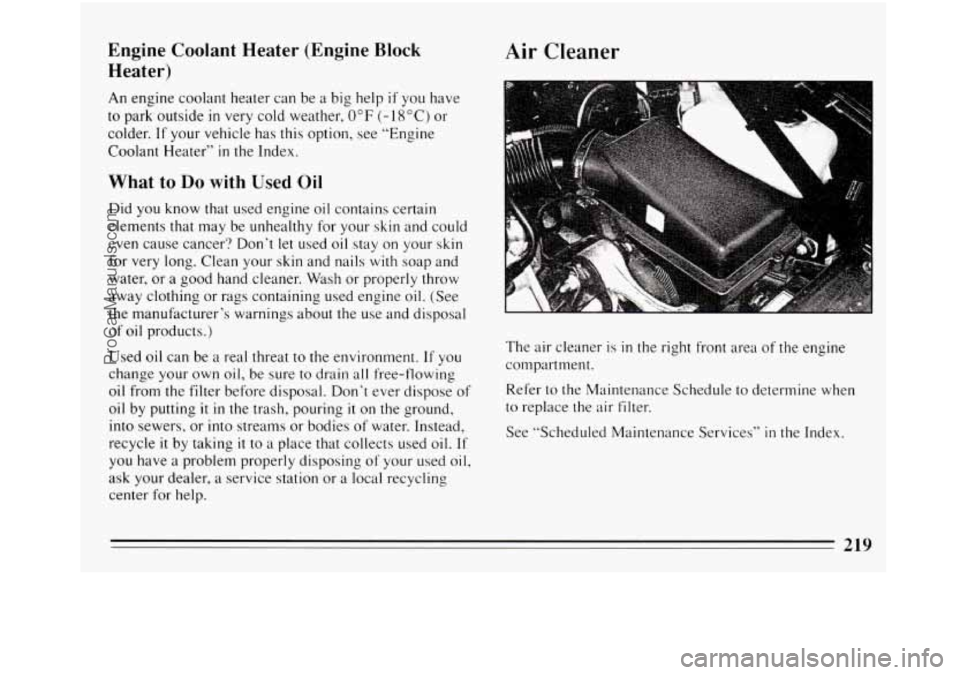
Engine Coolant Heater (Engine Block
Heater)
An engine coolant heater can be a big help if you have
to park outside in very cold weather, 0°F (- 18 “C) or
colder. If your vehicle has this option, see “Engine
Coolant Heater”
in the Index.
What to Do with Used Oil
Did you know that used engine oil contains certain
elements that may be unhealthy for your skin and could
even cause cancer? Don’t let used oil stay on your skin
for very long. Clean your skin and nails
with soap and
water,
or a good hand cleaner. Wash or properly throw
away clothing or rags containing used engine
oil. (See
the manufacturer’s warnings about the use and disposal
of
oil products.)
Used oil can be a real threat to the environment. If you
change your own
oil, be sure to drain all free-flowing
oil from the filter before disposal. Don’t ever dispose of
oil by putting it in the trash, pouring it on the ground,
into sewers, or into streams or bodies of water. Instead,
recycle
it by taking it to a place that collects used oil. If
you have a problem properly disposing of your used oil,
ask your dealer, a service station or a local recycling
center for help.
Air Cleaner
The air cleaner is in the right front area of the engine
compartment.
Refer to the Maintenance Schedule to determine when
to replace the air filter.
See “Scheduled Maintenance Services”
in the Index.
219
ProCarManuals.com
Page 222 of 308
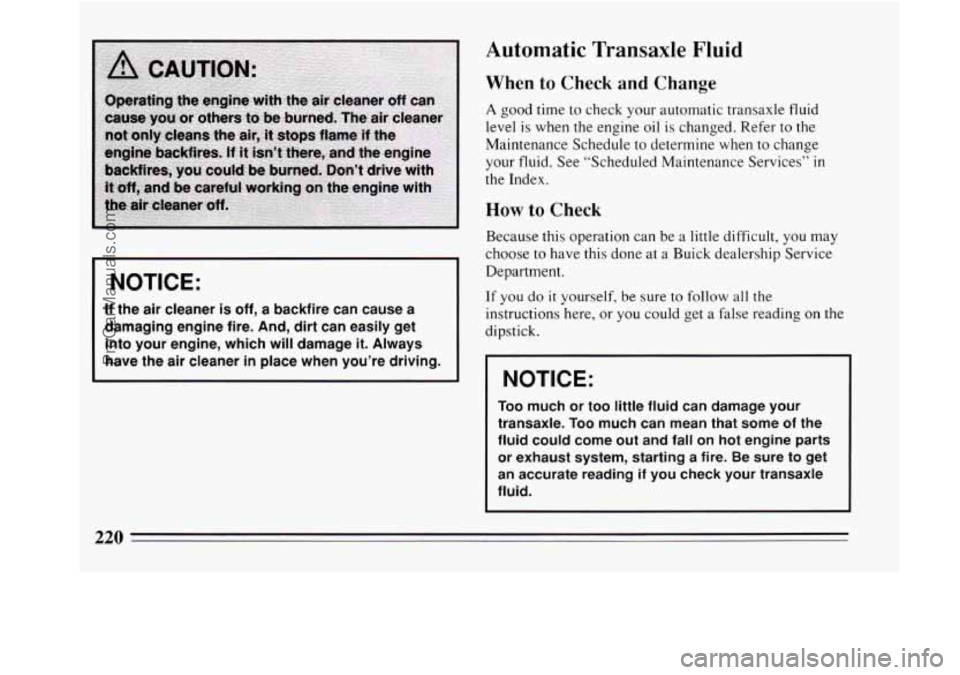
I NOTICE:
If the air cleaner is off, a backfire can cause a
damaging engine fire. And, dirt can easily get
into your engine, which will damage
it. Always
have the air cleaner
in place when you’re driving.
Automatic Transaxle Fluid
When to Check and Change
A good time to check your automatic transaxle fluid
level
is when the engine oil is changed. Refer to the
Maintenance Schedule to determine when to change
your fluid. See “Scheduled Maintenance Services” in
the Index.
How to Check
Because this operation can be a little difficult, you may
choose to have this done at a Buick dealership Service
Department.
If you do it yourself, be sure to follow all the
instructions here, or you could get a false reading on the
dipstick.
NOTICE:
Too much or too little fluid can damage your
transaxle.
Too much can mean that some of the
fluid could come out and fall on hot engine parts
or exhaust system, starting a fire. Be sure to get
an accurate reading
if you check your transaxle
fluid.
ProCarManuals.com
Page 223 of 308
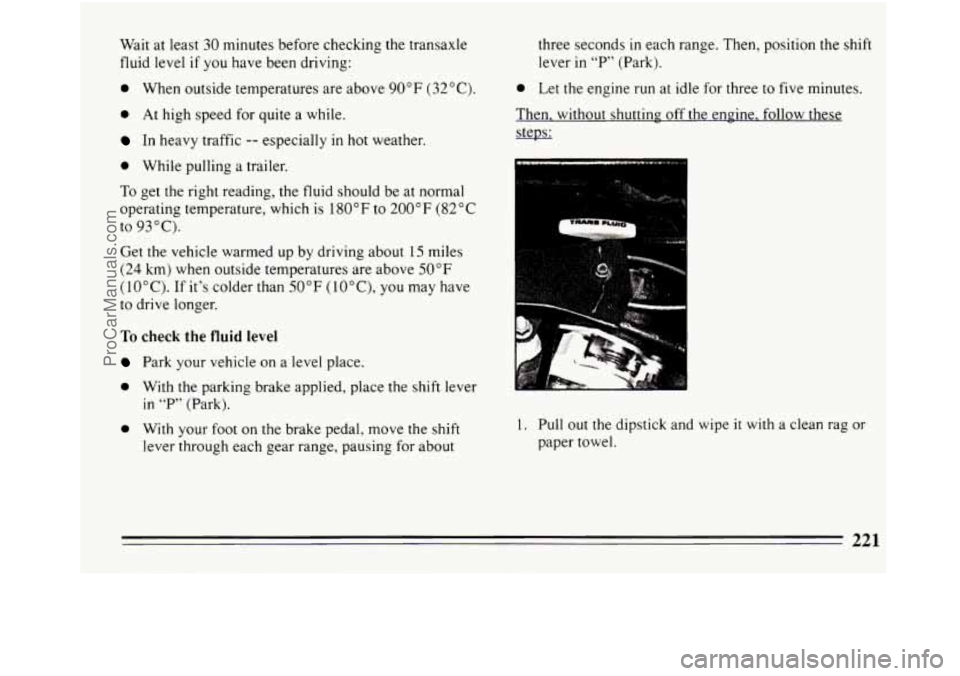
Wait at least 30 minutes before checking the transaxle
fluid level if you have been driving:
0 When outside temperatures are above 90°F (32°C).
0 At high speed for quite a while.
In heavy traffic -- especially in hot weather.
0 While pulling a trailer.
To get the right reading, the fluid should be at normal
operating temperature, which is
180°F to 200°F (82°C
to 93°C).
Get the vehicle warmed up by driving about 15 miles
(24 km) when outside temperatures are above 50°F
(10°C).
If it’s colder than 50°F (lO”C), you may have
to drive longer.
To check the fluid level
Park your vehicle on a level place.
0 With the parking brake applied, place the shift lever
0 With your foot on the brake pedal, move the shift
in “P” (Park).
lever through each gear range, pausing for about three seconds
in each range. Then, position the shift
lever
in “P” (Park).
0 Let the engine run at idle for three to five minutes.
Then, without shutting off the engine. follow these
steps:
1. Pull out the dipstick and wipe it with a clean rag or
paper towel.
ProCarManuals.com
Page 225 of 308
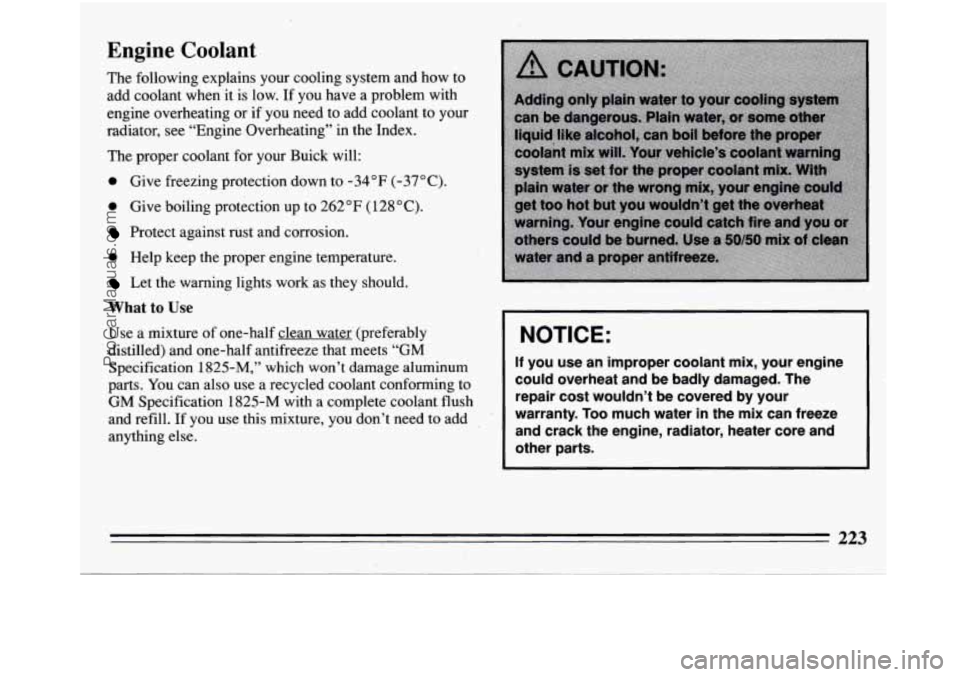
Engine Coolant
The following explains your cooling system and how to
add coolant when it is low. If you have a problem with
engine overheating or if you need to add coolant to your
radiator, see “Engine Overheating” in the Index.
The proper coolant for your Buick will:
0 Give freezing protection down to -34°F (-37°C).
0 Give boiling protection up to 262°F (128°C).
Protect against rust and corrosion.
0 Help keep the proper engine temperature.
Let the warning lights work as they should.
What to Use
Use a mixture of one-half clean water (preferably
distilled) and one-half antifreeze that meets “GM Specification
1825-M,” which won’t damage aluminum
parts. You can also use a recycled coolant conforming to
GM Specification 1825-M with a complete coolant flush
and refill.
If you use this mixture, you don’t need to add
anything else.
NOTICE:
If you use an improper coolant mix, your engine
could overheat and be badly damaged. The repair cost wouldn’t be covered by your
warranty. Too much water in the mix can freeze
‘and crack the engine, radiator, heater core and other parts.
223
ProCarManuals.com
Page 226 of 308
Adding Coolant
The coolant recovery tank is located at the left of the
engine compartment.
To Check Coolant
When your engine is cold, the coolant level should be at
“COLD” or a little higher. When your engine is warm,
the level should be up to
“HOT” or a little higher.
LOW
COOLANT
If this light comes on,
it means you’re low on
engine coolant.
To Add Coolant
If you need more coolant, add the proper mix at the
coolant recovery tank.
If the coolant recovery tank is completely empty, add
coolant to the radiator. (See “Engine Overheating” in the
Index.)
224
ProCarManuals.com
Page 227 of 308

A CAUTION:
Turning the radiator pressure cap when the
engine
and radiator are hot can allow steam and
scalding liquids
to blow out and burn you badly.
With the coolant recovery tank, you will almost
never have
to add coolant at the radiator. Never
turn the radiator pressure cap -- even a little --
when the engine and radiator are hot.
Add coolant mix at the recovery tank, but be careful not
to spill it.
A CAUTION:
You can be burned if you spifl coolant on hot
engine parts. Coolant contains ethylene glycol,
and
it will burn if the engine parts are hot
enough. Don’t spill coolant on a hot engine.
Radiator Pressure Cap
NOTICE:
Your radiator cap is a 15 psi (1 05 kPa)
pressure-type cap and must be tightly installed
to prevent coolant
loss and possible engine
damage from overheating. Be sure the arrows on
the cap line up with the overflow tube on the
radiator filler neck.
When you replace your radiator pressure cap, an AC@
cap
is recommended.
Thermostat
Engine coolant temperature is controlled by a thermostat
in the engine coolant system. The thermostat stops the
flow of coolant through the radiator until the coolant
reaches a preset temperature.
When
you replace your thermostat, an AC@ thermostat
is recommended.
225
ProCarManuals.com